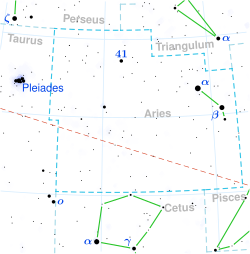Top Qs
Timeline
Chat
Perspective
Sigma Arietis
Star in the constellation Aries From Wikipedia, the free encyclopedia
Remove ads
Sigma Arietis is a star in the northern constellation of Aries. Its name is a Bayer designation that is Latinized from σ Arietis, and abbreviated Sigma Ari or σ Ari. This star has an apparent visual magnitude of +5.52,[3] which is bright enough for the star to be seen with the naked eye from dark suburban skies. The star is located at a distance of approximately 463 light-years (142 parsecs) from the Sun based on parallax measurements, and is drifting further away with a radial velocity of +17 km/s.[5] On November 20, 1952, it was observed being occulted by the planet Jupiter.[10]
Sigma Arietis is a B-type main sequence star with a stellar classification of B7 V.[4] This is a large star with three[7] times the radius of the Sun and 3.8[6] times the Sun's mass. It shines around 301[6] times as brightly as the Sun, with this energy being radiated into space from its outer atmosphere at an effective temperature of 13,121 K.[6] It is this heat that gives the star the blue-white hue of a B-type star. Sigma Arietis is spinning at a rapid clip, with a projected rotational velocity of 165 km/s.[6] It is about 36[8] million years old and is a probable member of the Cas-Tau OB association of stars that share a common motion through space.[11]
In 2016, a stellar companion was reported based on observations using adaptive optics with the Gemini North Telescope. This object has a mass equal to or slightly greater than the Sun. It has an effective temperature of 5,524 K.[8]
Remove ads
References
External links
Wikiwand - on
Seamless Wikipedia browsing. On steroids.
Remove ads

